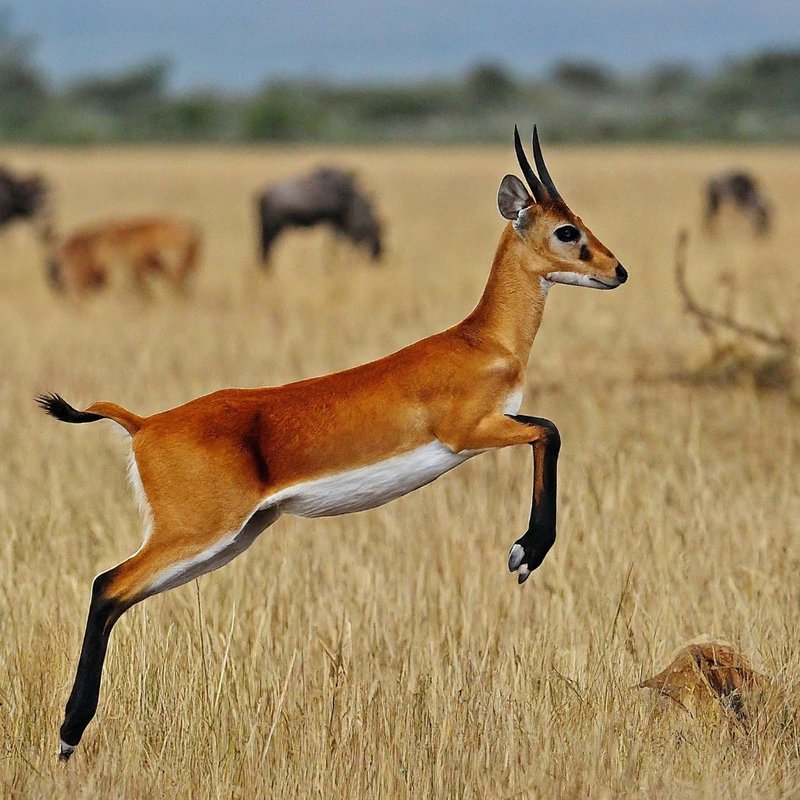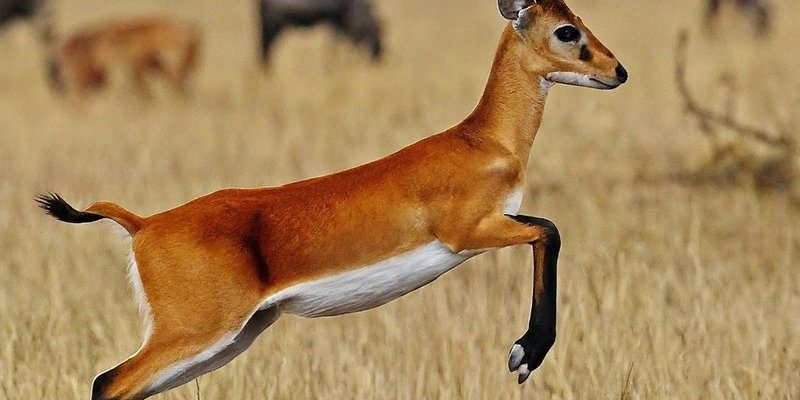
In this article, we’re going to explore ten animals that are similar to the oribi. We’ll break down how to identify each one and what makes them unique. By the end, you’ll have a better understanding of these fascinating creatures and the ecosystems they inhabit. So, grab a cup of coffee, sit back, and let’s dive in!
What is an Oribi?
The oribi (Ourebia ourebia) is a small antelope found mainly in grasslands and open woodlands. Mature adults stand around 60 to 75 cm tall at the shoulder and weigh between 12 to 22 kg. They usually have a light brown coat, which helps them blend in with taller grasses, making them harder to spot by predators.
Oribis are known for their incredible agility and speed. When threatened, they can leap up to 3 meters in a single bound! They typically live in small groups, often consisting of a few females and their young, while males are mostly solitary outside of the breeding season. Their unique body structure, big eyes, and gentle demeanor make them a delight to observe in their natural habitat.
1. Grant’s Gazelle
Grant’s gazelle (Nanger granti) shares a similar body shape with the oribi but is larger, standing about 90 cm tall at the shoulder. These gazelles have long, slender legs and a graceful neck.
Differences in Features
– Horns: Male Grant’s gazelles have long, curved horns that can reach up to 90 cm. Oribi horns are short and straight.
– Coloration: Grant’s gazelles have a more pronounced brown and white pattern on their coats, especially around the face and legs.
While both animals are known for their speed, Grant’s gazelle can run significantly faster. If you see a gazelle bounding across the savannah, it’s likely a Grant’s, not an oribi!
2. Impala
The impala (Aepyceros melampus) is another antelope often confused with the oribi. Standing about 80 to 90 cm tall, it has a sleek body and long legs.
How to Distinguish Them
– Size: Impalas are generally larger than oribis and have longer legs.
– Horns: Male impalas have long, lyre-shaped horns, which the oribi lacks.
– Behavior: Impalas are known for their impressive leaping ability, often displaying a unique bounding gait.
You might wonder how to tell them apart at a glance. Look for the impala’s distinctive black stripe on its hind leg, which is a giveaway!
3. Dik-Dik
Dik-diks (Madoqua spp.) are the smallest antelopes and are often mistaken for juvenile oribis. They stand only about 30 to 40 cm tall at the shoulder.
Identifying Features
– Size: They are much smaller than oribis, almost like a living plush toy!
– Facial Features: Dik-diks have elongated snouts and large eyes, giving them a very different face.
Their name comes from their distinctive alarm calls, which sound like “dik-dik.” If you hear that sound, you’re likely close to a dik-dik!
4. Suni
Similar in size to the oribi, the suni (Neotragus moschatus) is another small antelope native to forests. They tend to be slightly stockier and live in more densely vegetated areas.
Key Differences
– Habitat Preference: Unlike the oribi that favors open grasslands, sunis prefer thick bushland or forests.
– Color and Markings: Sunis tend to have a deeper reddish-brown coat with distinct white markings on their faces and legs.
These little antelopes are shy and rarely seen, often staying hidden in the underbrush. If you spot one, consider yourself lucky!
5. Bushbuck
The bushbuck (Tragelaphus sylvaticus) is a medium-sized antelope that resembles the oribi but is characterized by a thicker build and distinctive markings.
Distinguishing Factors
– Build and Size: Bushbucks are larger than oribis, standing 80 to 100 cm tall.
– Coloration: They have a dark to reddish-brown coat with white spots and stripes, and males have twisted horns.
Bushbucks are also more elusive, often staying in dense foliage. If you spot a bushbuck, take note of its striking white markings, which really stand out against its darker coat.
6. Waterbuck
The waterbuck (Kobus ellipsiprymnus) is a larger antelope that can weigh up to 125 kg and stands about 90 to 120 cm tall.
Identifying Features
– Size Differences: Waterbucks are much bulkier and significantly larger than oribis.
– Distinctive Markings: They have a white ring on their hindquarters and a shaggy coat, unlike the sleek oribi.
Waterbucks are often found near water sources, which is a critical part of their habitat. If you’re by a river, look for the big, shaggy waterbuck lounging by the water!
7. Rhebok
The rhebok (Pelea capreolus) is another antelope that can be confused with the oribi, especially because of their similar body shape.
How to Tell Them Apart
– Coloration: Rheboks are a bit lighter in color and have a distinctive white stripe along the side of their body.
– Horns: Male rheboks have short, straight horns that differ from the oribi’s characteristics.
Rheboks are often found in mountainous terrain, which can serve as an indicator of their presence. If you’re hiking and see a nimble antelope, it might just be a rhebok!
8. Nyala
The nyala (Tragelaphus angasii) is a larger antelope that stands out due to its unique coloration and larger frame.
Key Identifiers
– Size: Nyala males can weigh up to 120 kg and are taller and bulkier than oribis.
– Coloration: Males are dark brown with white stripes, while females are generally tan.
While they may share similar habitats, their size and unique coloring make them easy to spot once you know what to look for.
9. Kudu
The greater kudu (Tragelaphus strepsiceros) is another large antelope species that bears some resemblance to the oribi but is much bigger.
Identifying the Kudu
– Size: Kudus can weigh between 90 to 120 kg and are quite tall, standing about 1 meter at the shoulder.
– Horns: Males have impressive twisted horns that can spiral up to 1.5 meters.
Kudus tend to be more solitary and prefer bushy areas, unlike the social oribi. If you catch a glimpse of a kudu, admire those majestic horns!
10. Thompson’s Gazelle
Last but not least, the Thompson’s gazelle (Eudorcas thomsonii) is another animal to consider, particularly if you’re observing a herd of gazelles.
Key Differences
– Appearance: Thompson’s gazelles are smaller and more slender than oribis, making them quite agile.
– Coloration: They have a distinctive black stripe on their side, which is absent in the oribi.
Because they are often found in open grasslands, it can be interesting to watch how they graze in groups. You’ll easily spot them darting around if you pay close attention!
In conclusion, while the oribi is a remarkable little antelope, it shares its space with a variety of other fascinating creatures. Each animal has unique characteristics and behaviors that help them thrive in their respective environments. By understanding these differences, you can enhance your wildlife-watching experience and appreciate the diversity of the animal kingdom. So next time you’re out in the wild, keep an eye out for these delightful animals—each one a unique part of nature’s tapestry!

